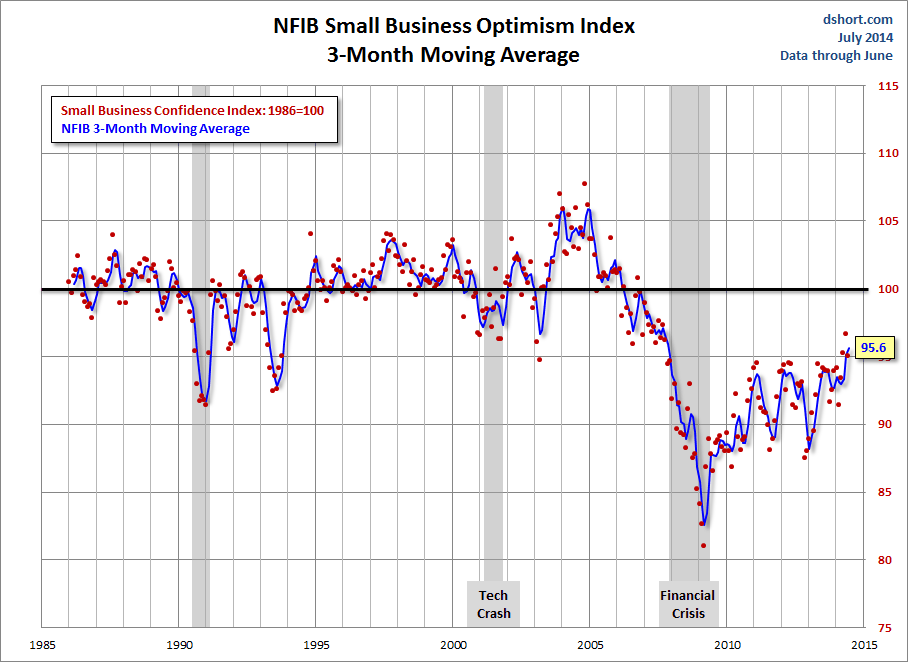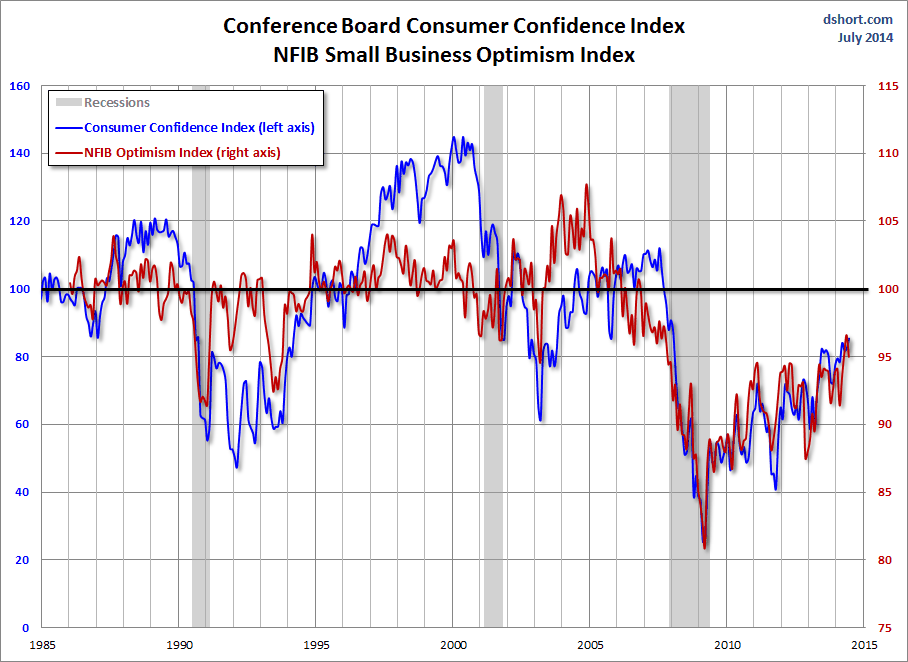The latest issue of the NFIB Small Business Economic Trends is out today. The July update for June came in at 95.0, down 1.6 points from the previous month's 96.6. Today's headline number marks a reversal after three months of improvement. The index is now at the 26.0 percentile in this series, a level it first achieved in October 2007, two months before the last recession.
The Investing.com forecast was for 97.3.
Here is the opening summary of the news release, which takes a typically cautious view of the survey findings.
After a promising 3 month run, June’s Optimism Index fell 1.6 points to 95.0. While job components improved, capital outlays and planned spending faded along with expectations for improving business conditions. Overall only two Index components improved, two were unchanged, and six fell. (Link to press release).
The first chart below highlights the 1986 baseline level of 100 and includes some labels to help us visualize that dramatic change in small-business sentiment that accompanied the Great Financial Crisis. Compare, for example the relative resilience of the index during the 2000-2003 collapse of the Tech Bubble with the far weaker readings of the past four years. The NBER declared June 2009 as the official end of the last recession.
The average monthly change in this indicator is 1.3 points. To smooth out the noise of volatility, here is a 3-month moving average of the Optimism Index along with the monthly values, shown as dots.
Inventories And Sales
The findings on small business inventories and sales have improved. The excerpts below are from the latest monthly report (PDF format).
| The net percent of all owners (seasonally adjusted) reporting higher nominal sales in the past 3 months compared to the prior 3 months fell 1 point to a net negative 2 percent, still one of the very best readings of the recovery period. Thirteen percent cite weak sales as their top business problem, one of the lowest readings since December 2007, the peak of the expansion. Expected real sales volumes posted a 4 point decline, falling to a net 11 percent of owners expecting gains. Lower sales expectations offers no motivation for owners to hire or order more inventories. |
Credit Markets
Has the Fed's zero interest rate policy and quantitative easing had a positive impact on Small Businesses?
| Six percent of the owners reported that all their credit needs were not met, up 1 point and 2 points above the record low. Twenty-seven percent reported all credit needs met, and a record 54 percent explicitly said they did not want a loan. Only 3 percent reported that financing was their top business problem. Twenty-eight percent of all owners reported borrowing on a regular basis, down 3 points. A net 6 percent of regular borrowers reported loans “harder to get” compared to their last attempt. The average rate paid on short maturity loans was unchanged at 5.7 percent. |
NFIB Commentary
This month's "Commentary" section opens with the following observations:
| According to the NFIB June survey, June was the best employment month in recent years. BLS agreed, although the headline jobs report was better than the details. Part-time workers rose 1.12 million while full-time employment fell by 523,000. Thus, we swapped two part-time workers for each full-time job lost, not an efficient way to structure the workforce but that reflects the incentive structure created by Washington. Aggregate hours worked were little changed from 2007. The hours worked index was 100.8 for June vs 100 in 2007. After 6 ½ years of “recovery”, the same number of workers are now employed as at the peak in January, 2008, the population of eligible labor force participants is 14 million higher and more of the existing jobs are part-time jobs. |
Business Optimism and Consumer Confidence
The next chart is an overlay of the Business Optimism Index and the Conference Board Consumer Confidence Index. The consumer measure is the more volatile of the two, so I've plotted it on a separate axis to give a better comparison of the volatility from the common baseline of 100.
These two measures of mood have been highly correlated since the early days of the Great Recession.
Which stock should you buy in your very next trade?
AI computing powers are changing the stock market. Investing.com's ProPicks AI includes 6 winning stock portfolios chosen by our advanced AI. In 2024 alone, ProPicks AI identified 2 stocks that surged over 150%, 4 additional stocks that leaped over 30%, and 3 more that climbed over 25%. Which stock will be the next to soar?
Unlock ProPicks AI


